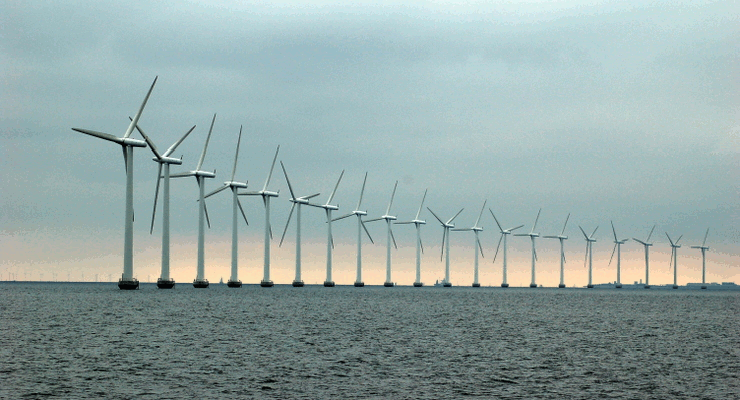Almost £200 billion pounds of investment in Britain’s continuing green energy revolution are about to be released for nearly 11GW of new capacity, thanks to this morning’s awards of Contracts for Difference (CfDs) in Allocation Round 4.
Across a total of 93 projects, the largest deals rewarded by D-BEIS in AR4 see Ørsted being told the 15 year price it can expect for power made by its Hornsea 3 wind farm in the North Sea, at 2.85GW the world’s single most powerful marine power plant.
Against an inflation-indexed strike price of £37.35 per MWh in 2012 prices for 2026/27, Hornsea 3 is a key enabler in the government’s goal of 50GW of offshore wind capacity by 2030.
For comparison, the 22.5GW Hinkley C nuclear plant has a strike price of £92.50 per MWh.
SSE’s 0.443GW Viking wind farm on the Shetlands is also among the winners, contributing to a projected total of 8.511GW of wind generation in today’s AR4 announcements.
Viking has secured a CfD for 220MW- half of of its total capacity – at a strike price of £46.39/MWh for the 2026/27 delivery year. The successful project will receive its guaranteed strike price, set on 2012 prices but annually indexed against the CPI, for the contracted low carbon electricity which it will make over its first 15 years.
Summarised as follows by technology, Britain’s latest allocations from auctions spurring green electricity at predictable prices sees contracts awarded at the following clearing prices and capacities:
| Technology Pot | Clearing prices, capacities | Sample FY: 2024/25 | Sample FY: 2026/27 | Total capacity, MWp, 2023-2027 | |
| Solar PV, >5MW | 1 | £ /MWh | £45.99 | n/a
|
2,209.41 |
| MW | 1,9508.03 | n/a | |||
| Onshore wind, >5W | 1 | £ /MWh | £42.47 | n/a | 887.96 |
| MW | 888.96 | n/a | |||
| Energy from waste, CHP | 1 | £ /MWh | £45.99 | n/a | 30.00 |
| MW | 30.00 | n/a | |||
| Tidal stream | 2 | £ /MWh | n/a | £178.54 | 40.82 |
| MW | n/a | 35.20 | |||
| Offshore wind, floating | 2 | £ /MWh | n/a | £87.30 | 32.00 |
| MW | n/a | 32.00 | |||
| Offshore wind, embedded | 2 | £ /MWh | n/a | £37.35 | 6,994.34 |
| MW | n/a | 6,994.34 | |||
| Remote island wind | 3 | £ /MWh | n/a | £46.39 | 597.60 |
| MW | n/a | 597.60 |
Total new capacity across all technologies – including the less proven Pot 3 variety – is 10,792 MW. Of that total, wind in all forms takes 79%, and offshore wind takes 65%.
Consented in December 2020, Hornsea 3 will support up to 5,000 jobs during construction. Another 1,200 permanent jobs will be needed both directly and in the supply chain during the project’s lifetime Hornsea 3 will be operated from Ørsted’s base in Grimsby.
Its 231 towers to be erected across nearly 700 square kilometres of the southern North Sea will feature among the £ 14 billion which the Danish engineers plan to spend before 2030 in the UK, according to country head Duncan Clark.
“Successive governments deserve credit for providing the regulatory and policy certainty for continued investment in offshore wind”, Clark added.
“Now more than ever there is a need for the further development of renewable energy, not only to address the increasing threats from climate change, but also to increase the stability and resilience of energy supply. We look forward to working with government and industry colleagues to accelerate the deployment of offshore wind.”
Hornsea 3 is planned to be generating in 2027, with revenues underpinned by the 15 year CfD. Its strike price is inflation-indexed up throughout the CfD period. The nominal starting price per MWh will be determined based on the strike price plus accumulated inflation from 2012 until the CfD starts. When the CfD expires, Hornsea 3 will receive the market price for electricity or enter new power purchase agreements.
Large-scale solar features in the CfD rounds for the first time since 2015. Sixty-six photovoltaic projects receive contracts, outpacing 27 wind, tidal and energy-from-waste ventures.
Cleve Hill solar farm in Kent was the first to be approved as a nationally significant infrastructure project. A third of its 350MW capacity will be covered by a CfD. No other solar project exceeds 50 megawatts. The two smallest are 6MW.
For the solar industry, SolarEnergyUK commented: “Today’s announcement of over 2GW of subsidy free contracts cements solar as a major part of the solution to Britain’s energy security crisis. Solar and wind are now undeniably the cheapest, as well as the cleanest, ways to power the country”.
Full details of today’s AR awards are here.




